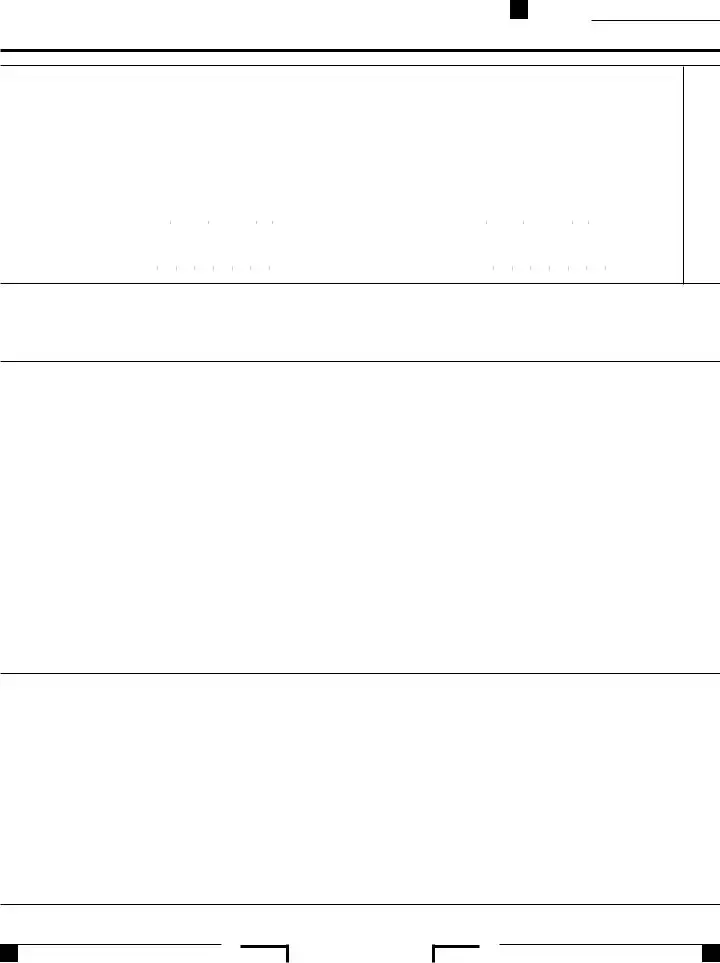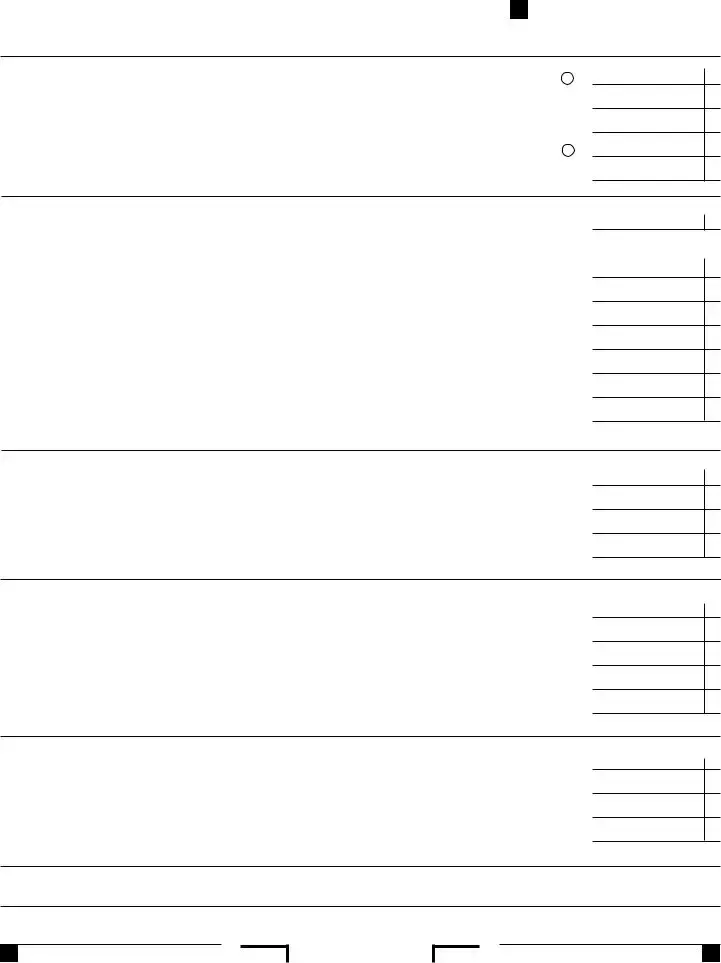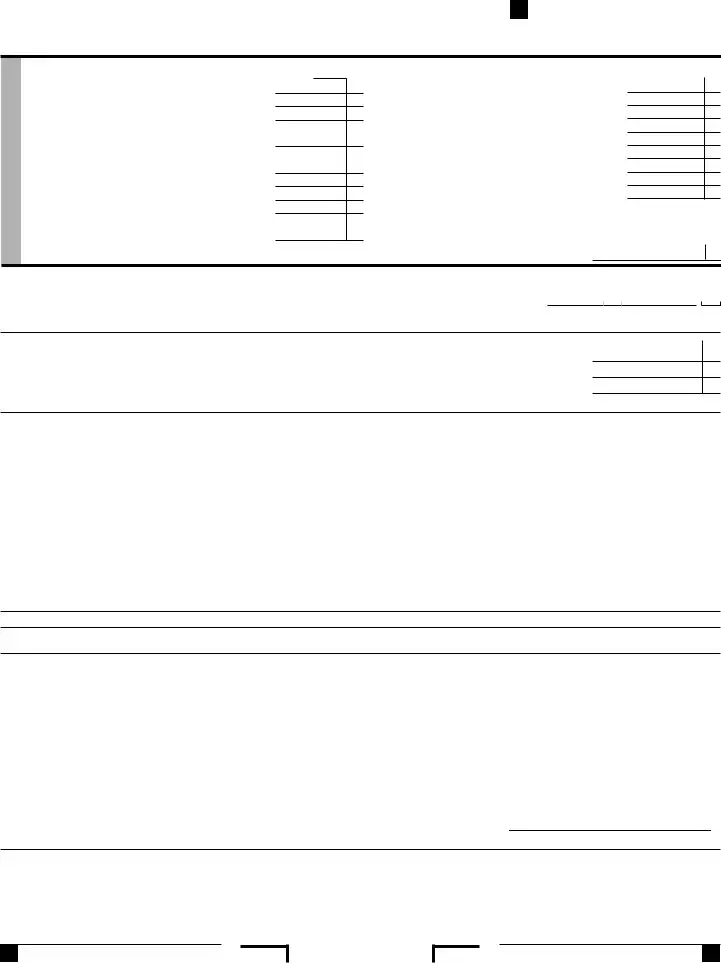Your name: __________________________________ Your SSN or ITIN: ____________________________
|
|
31 |
Tax. Check the box if from: Tax Table |
Tax Rate Schedule |
FTB 3800 FTB 3803 |
|
. . |
31 |
|
|
32 |
Exemption credits. Enter the amount from line 11. If your federal AGI is more than $169,730 (see page 10) . . |
▐ |
32 |
Tax |
|
33 |
Subtract line 32 from line 31. If less than zero, enter -0- |
. . . . . . . . . . . |
. . . . . . . . . . . . . . . . . . . |
|
. . |
▐ |
33 |
|
|
34 |
Tax (see page 11). Check the box if from: |
Schedule G-1 FTB 5870A |
|
. . |
34 |
|
|
35 |
Add line 33 and line 34 |
. . . . . . . . . . . . . . . . . . . . |
. . . . . . . . . . . |
. . . . . . . . . . . . . . . . . . . |
|
. . |
▐ |
35 |
|
|
40 |
Nonrefundable Child and Dependent Care Expenses Credit (see page 11). Attach form FTB 3506 |
|
. . |
40 |
|
|
41 |
New jobs credit, amount generated (see page 11) |
41 |
|
|
|
|
|
|
|
00 |
|
|
Credits |
|
42 |
. . . . . . . . . . . . . . . . .New jobs credit, amount claimed (see page 11) |
. . . . . . . . . . . |
. . . . . . . . . . . . . . . . . . . |
|
. . |
42 |
|
43 |
Enter credit name▐_______________________________code number________ and amount |
|
|
43 |
|
|
|
. . |
Special |
|
44 |
Enter credit name▐_______________________________code number________ and amount |
|
. . |
44 |
|
45 |
To claim more than two credits (see page 12). Attach Schedule P (540) |
|
|
45 |
|
|
|
. . |
|
|
46 |
Nonrefundable renter’s credit (see page 12) |
. . . . . . . . . . . . . . . . . . . . |
. . . . . . . . . . . |
. . . . . . . . . . . . . . . . . . . |
|
. . |
46 |
|
|
47 |
Add line 40 and line 42 through line 46. These are your total credits . |
. . . . . . . . . . . |
. . . . . . . . . . . . . . . . . . . |
|
. . |
▐ |
47 |
|
|
48 |
Subtract line 47 from line 35. If less than zero, enter -0- |
. . . . . . . . . . . |
. . . . . . . . . . . . . . . . . . . |
|
. . |
▐ |
48 |
Taxes |
|
61 |
Alternative minimum tax. Attach Schedule P (540) |
. . . . . . . . . . . |
. . . . . . . . . . . . . . . . . . . |
|
. . |
61 |
|
62 |
Mental Health Services Tax (see page 13) . |
|
|
|
|
|
|
62 |
Other |
|
. . . . . . . . . . . . . . . . . . . . |
. . . . . . . . . . . |
. . . . . . . . . . . . . . . . . . . |
|
. . |
|
63 |
Other taxes and credit recapture (see page 13) |
|
|
|
|
|
63 |
|
|
. . . . . . . . . . . |
. . . . . . . . . . . . . . . . . . . |
|
. . |
|
|
64 |
Add line 48, line 61, line 62, and line 63. This is your total tax |
. . . . . . . . . . . |
. . . . . . . . . . . . . . . . . . . |
|
. . |
64 |
|
|
71 |
California income tax withheld (see page 13) |
. . . . . . . . . . . |
. . . . . . . . . . . . . . . . . . . |
|
. . |
71 |
Payments |
|
72 |
2012 CA estimated tax and other payments (see page 13) |
. . . . . . . . . . . |
. . . . . . . . . . . . . . . . . . . |
|
. . |
72 |
|
73 |
Real estate and other withholding (see page 13) |
|
|
|
|
|
73 |
|
|
. . . . . . . . . . . |
. . . . . . . . . . . . . . . . . . . |
|
. . |
|
|
74 |
Excess SDI (or VPDI) withheld (see page 13) |
. . . . . . . . . . . |
. . . . . . . . . . . . . . . . . . . |
|
. . |
74 |
|
|
75 |
Add line 71, line 72, line 73, and line 74. These are your total payments (see page 14) |
|
. . |
▐ |
75 |
OverpaidTax/ |
TaxDue |
91 |
Overpaid tax. If line 75 is more than line 64, subtract line 64 from line 75 |
|
. . |
▐ |
91 |
94 |
Tax due. If line 75 is less than line 64, subtract line 75 from line 64. . |
. . . . . . . . . . . |
. . . . . . . . . . . . . . . . . . . |
|
. . |
▐ |
94 |
|
|
92 |
Amount of line 91 you want applied to your |
2013 estimated tax . . . . |
. . . . . . . . . . . |
. . . . . . . . . . . . . . . . . . . |
|
. . |
|
92 |
|
|
93 |
Overpaid tax available this year. Subtract line 92 from line 91 |
. . . . . . . . . . . |
. . . . . . . . . . . . . . . . . . . |
|
. . |
93 |
Use |
Tax |
95 |
Use Tax. This is not a total line (see page 14) |
. . . . . . 95 |
|
|
00 |
|
|
|
|
|






 .
.